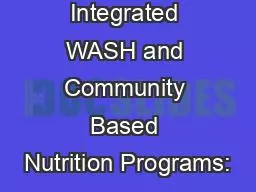

insights from a fiveyear UNICEF program in Ethiopia Authors Samuel Godfrey Jane Bevan Katherine F Shields Argaw Ambelu Ronna Chan Georgia Kayser Jamie Bartram Sanitation in Ethiopia ID: 802934
Download The PPT/PDF document "Integrated WASH and Community Based Nutr..." is the property of its rightful owner. Permission is granted to download and print the materials on this web site for personal, non-commercial use only, and to display it on your personal computer provided you do not modify the materials and that you retain all copyright notices contained in the materials. By downloading content from our website, you accept the terms of this agreement.
Slide1
Integrated WASH and Community Based Nutrition Programs:
insights from a five-year UNICEF program in Ethiopia
Authors: Samuel Godfrey, Jane Bevan, Katherine F. Shields, Argaw Ambelu, Ronna Chan, Georgia Kayser, Jamie Bartram
Slide2Sanitation in Ethiopia
FMoH/UNICEF/EU Situation Analysis of the Nutrition Sector in Ethiopia: 2000-2015. Ethiopian Federal Ministry of Health, UNICEF and European Commission Delegation. Addis Ababa, Ethiopia 2016
Ethiopia
Sanitation
National*
Rural
Urban*Safely managed-4-Basic service7118Limited service7130Unimproved596244No service27327 *No safely managed estimate available
Slide3Malnutrition in Ethiopia
Data from 2016 DHS
Slide4Rural Water Supply
Rural
water supplies in
30 Districts
benefiting 1,800 communities
Sanitation & Hygiene
Community Led Total Sanitation and Hygiene resulting in home built toilets, benefiting 280,000 familiesWASH in Schools150 rural primary schools (97,500 school children) with a complete WASH packageWASH in Health Centers150 rural health facilities with complete WASH packageDemonstration of MUSEstablishment of 60 school-managed market gardens to demonstrate the benefits of MUSEnhancing Capacity and KnowledgeStrengthened capacity for communication for behavior and social change in schools and communitiesKnowledge generation and dissemination through networks and fora to inform policy and practiceCBN PackageScaling-up of CBN package in 15 Districts targeting 134,000 children under-two years with GMP, counseling on infant and young child feeding best practicesComplementary FoodsSupporting local production of complementary foods targeting 60 per cent of children under-two years and promote household garden to improve dietary diversityCommunity Health DaysBiannual provision of vitamin A and deworming capsules and quarterly screening of children under 5 and pregnant and lactating mothers for malnutrition and referral to HFCapacity of health workersStrengthening the capacity of health workers on nutrition and data managementNutrition EducationEstablishing nutrition education in 60 per cent of the schools through nutrition clubs and BCC activitiesMicronutrient SupplementationProviding micronutrient supplementation to pregnant and lactating mothers and adolescent girls in and out of school with strong BCC
WASH & MUS
CBN
Integrated WASH, MUS and CBN
UNICEF Ethiopia WASH/CBN
Program components 2012 to 2017
Slide5UNICEF Ethiopia WASH/CBN Implementation regions
SNNPR
Oromia
Amhara
Tigray
Slide6Outcomes of Interest
StuntingHeight for age z-score 2 standard deviations or more below normal.Baseline: children under the age of fiveMidline: children measured at baseline, new children under the age of five
DiarrheaSelf-reported by head of householdAsked for each member of the householdAnalyzed for children under the age of five
Slide7Program groups
Slide8Intervention
30
woredas
576
kebeles
319 CBN & CLTSH
kebeles33-50 householdsdepending on region33% houses withoutchildrenControl92 woredas2,158 kebeles4 Regions27 CBN & MUSkebeles230 CBN & CWSkebeles
22 CBN & CH&S
kebeles
2 CBN & MUS
kebeles
16 CBN & CWS
kebeles
67% houses with children
< 5
40-44 households
depending on region
33% houses
without
children
67% houses with children
< 5
36-39 households
depending on region
33% houses
without
children
67% houses with children
< 5
Slide9Intervention
30
woredas
576
kebeles
319 CBN & CLTSH
kebelesControl92 woredas2,158 kebeles4 Regions27 CBN & MUSkebeles230 CBN & CWSkebeles40 controlkebeles38-42 householdsdepending on region33% houses
without
children
67% houses with children
< 5
Slide10Data collection
Baseline conducted June – Aug 2013Midline: January-March 2017
30 Woredas (Districts)80 kebeles (sub-districts)4 surveysHouseholdCommunityWaSH committeeSchool
Slide11Key Results
Stunting reduction across the study is in range of 7-9%, about 2.2% per year
This compares with the national rate of reduction (DHS) of 1.2% per yearNo evidence of difference
between
CBN and
WaSH+CBN
groups from baseline to midlineafter controlling for child age, child gender and region.Diarrheal disease prevalence uncommon (2-4%)
Slide12Diarrheal prevalence by Age Group
Slide13Mean height-for-age Z-score (HAZ) Stunting
Slide14Mean weight-for-age Z-score (WAZ)Underweight
Slide15Mean weight-for-height Z-score (WHZ) - Wasting
Slide16Stunting: Sanitation Vs Water
Predicted probabilities for likelihood of stunting based on a difference-in-difference analysis of stunting controlling for child age, access to drinking water and sanitation type
Shows differential
effect of improved versus unimproved
drinking water source
by age
group, not for sanitation Sanitation Drinking water Child age
Slide17Practices to reduce diarrhea
Slide18Conclusions and Way Forward
Conclusions
Way ForwardStunting reduction across the board higher than national rate despite El Nino drought (2015-2016)
CBN is being scaled up across the country to support the continued decline of stunting
Convergence of programmes will continue
No statistically significant change in the primary outcomes (stunting and diarrhea) between the two study groups from baseline to midline
Sanitation marketing is being rolled out to increase and improve existing sanitation coverage Baby WASH added to programme to focus specifically on child faeces disposal, infant hygiene and safe play areasDiarrheal prevalence lower than expected based on 2011 DHS results and recent AWD outbreaksChallenges with access, reduced sample size, seasonal variations to be addressed for endline, planned for 2020Data analysis suggests higher impact of water quality on stunting than sanitationSupporting GoE on regulating water safety plans and water quality managementMinimum dietary diversity was found to be very low at baseline and midline, but in-line with the findings from the DHSCBN is being scaled up across the country to support the continued decline of stunting
Slide19Acknowledgements and Thanks
With support from:
Government of Ethiopia
And National Partners Plan, SNV, IDE, Ripple
Thank you!